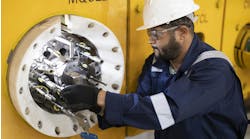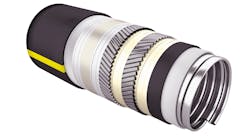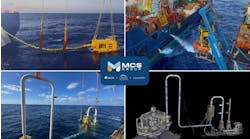Contract awards
Gene Kliewer • Houston
Cameron reports receipt of a $650-million contract to supply subsea systems for Total’s Usan’s 44-well subsea development offshore Nigeria. According to the contract, Cameron will provide subsea system engineering and project management in addition to subsea christmas trees, production and intervention controls, manifolds, flowline connectors, installation support, and spare parts to Elf Petroleum Nigeria. Delivery and installation is scheduled to run until 2012.
Usan is 62 mi (100 km) offshore Nigeria in 2,460 ft to 2,788 ft (750 m to 850 m). Elf holds 20%, Nexen 20%, Chevron 30%, and Esso 30%.
Anadarko Petroleum Corp. has awarded Technip a contract for expansion work at the K2 field in the GoM. Anadarko reportedly plans to tieback two wells to existing subsea equipment and to the Marco Polo platform with production flowlines. The wells are in Green Canyon blocks 562 and 606 at 1,200 m (4,000 ft) water depth.
Technip is to supply project management and engineering; fabrication, and installation of two rigid flowlines; design, fabrication, and installation of four PLETs; installation of two static umbilicals; tie-ins; precommissioning; and surveys. Flowline production is scheduled for the Technip spoolbase in Mobile, Alabama. Installation is scheduled for 3Q 2009 using theDeep Blue pipelay vessel.
Contract awards for work in Brazil are announced. Dril-Quip do Brasil Ltd. got a three-year, $180-million contract to supply subsea wellhead systems.
FMC Technologies Inc. will manufacture and install surface wellheads and surface production trees for StatoilHydro at Peregrino. Peregrino is a heavy oil development in 400 ft (120 m) of water in Campos basin. Development is divided into three phases and will total about 60 wells. The first phase of FMC’s contract covers 30 production and seven injection wells. Deliveries are expected to start in 1Q 2010 from FMC’s Rio de Janeiro facility.
GE Oil & Gas has a $250-million, three-year contract to supply 250 VetcoGray subsea wellheads for delivery starting in July. The wellheads are to be manufactured at GE’s Jandira facility in São Paulo. GE says it is negotiating with Petrobras to supply services for the equipment under a separate contract.
Ultra deepwater lab opens at Nalco
A new laboratory dedicated to R&D for ultra deepwater applications now is open at Nalco Co.’s Energy Services Division in Sugar Land, Texas.
Constructed and equipped at a cost of almost $3 million, the new laboratory came out of Nalco’s recognition that ultra deepwater applications have special technical challenges, said Stephan J. Allenson, industry fellow, OFC Research for Nalco in introducing the facility.
Current work in the lab involves investigation into processes involved with lift, subsea separation, and cold flow.
High-pressure North Sea hot tap completed
A successful high-pressure hot tap has facilitated tie-in of the North Sea’s Ettrick field bas export pipeline. T.D. Williamson SA performed the operation for Acergy on the Nexen Petroleum UK Ltd. pipeline
Throughout the tie-in, the pipeline pressure was 117 bar (11.7 MPa) in 94 m (311 ft) of water.
Acergy supplied engineering, procurement, installation, and precommissioning on the project and awarded TD Williamson a contract to engineer and supply all bespoke hot tap equipment and equipment testing.
Statoil, Framo working on wet gas compression
Framo Engineering and StatoilHydro have a contract to develop and qualify a subsea boosting system based on subsea wet gas compression. The two-year contract is a step toward a subsea multiphase compressor which StatoilHydro and its Gullfaks partners plan to use at start-up in 2013.
The Gullfaks field lies in block 34/10 in the northern part of the Norwegian North Sea and has been developed with three concrete production platforms. Four satellite fields – Gullfaks South, Rimfaks, Skinfaks, and Gullveig – have been developed with subsea wells remotely controlled from the Gullfaks A and C platforms.
Schematic illustrates the APL Offshore Singapore Pte Ltd. Submerged Turret Loading buoy with diverless bend stiffener connectors from First Subsea Ltd. First Subsea plans four stiffeners for two STL buoys destined for Neptune Deep Water Project North and South. APL says it is aiming for a completely diverless installation and operation of the loading system. The DBSC uses First Subsea’s Ballgrab ball and taper technology where female DBSC connectors are integrated into the STL buoy ahead of tow out. The DBSC male connectors are then inserted offshore to provide a secure connection for a gas offloading riser bend stiffener within a J tube and an umbilical within an I tube on each of the buoys. The risers and umbilicals are secured at the top of each respective I/J tube.





